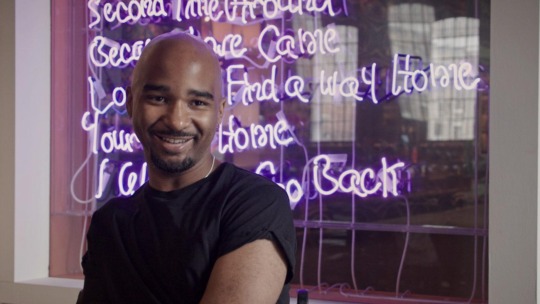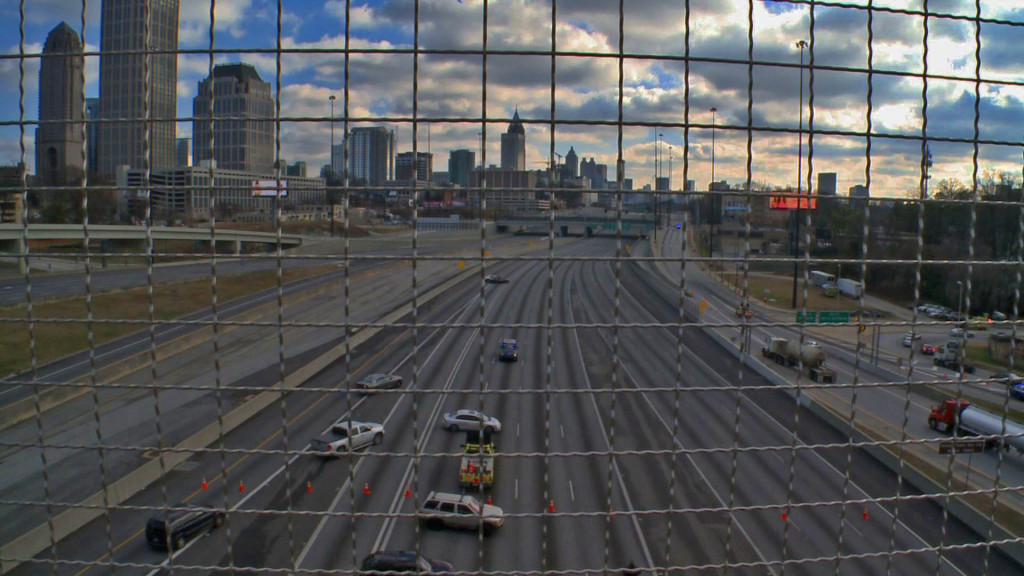
Were you stuck in that hellacious traffic jam on Monday, when I-75/85 was closed at 14th Street because of a suspicious object? What did you think when you found out that Georgia State University art students were to blame?
Shortly after 1PM on February 2, police and then the bomb squad were called to the scene to investigate a tube-shaped device duct-taped to the 14th Street bridge. After the “suspicious object” was detonated, the object was identified as a pinhole camera—one of 18 cameras, in fact, that had been placed by students in various locations around Atlanta. They were being used by the students to track the rising and setting of the sun over a three-month period.
Yes, the whole event was spurred by an innocuous mishap, the product of a harmless undergraduate class assignment. The university has apologized, and whether or not the students will be charged with reckless behavior has yet to be determined.
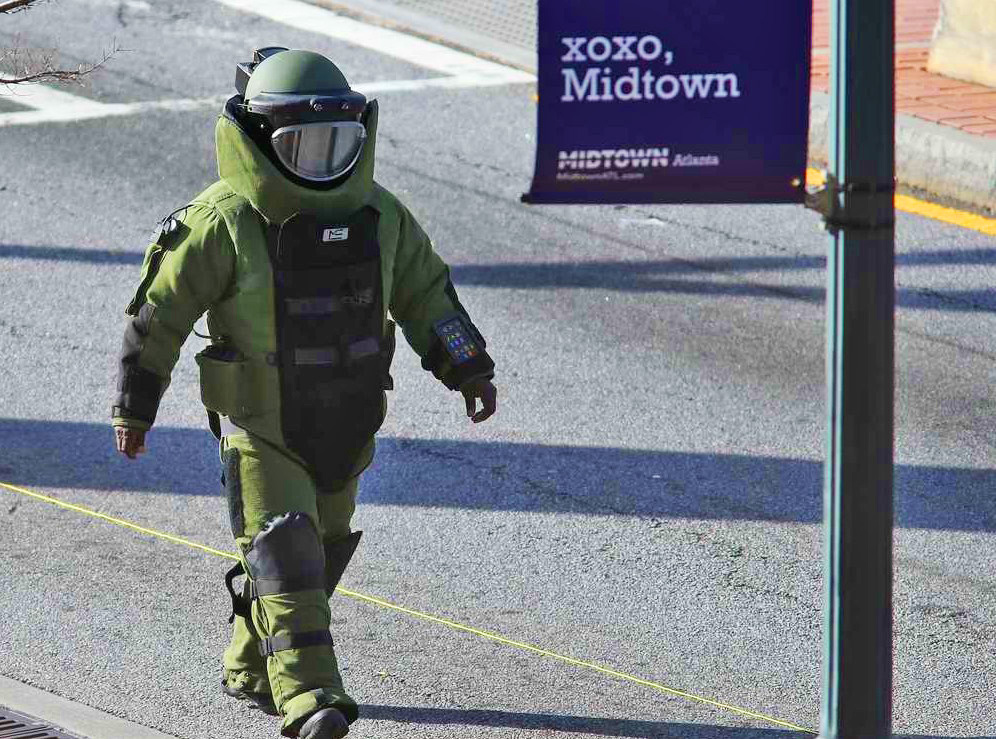
There is, unfortunately, a recent history of art students creating and placing (fake) bombs in public areas. In December 2002, Clinton Boisvert, an art student at the School of Visual Arts in New York City, was arrested for placing 38 black boxes with the words “fear” painted on them throughout the Union Square subway station, the area where ad-hoc 9/11 memorials had appeared and candlelight vigils were held immediately after the Trade Center attacks. And nearly four years later, two juniors at the Pratt Institute, Robert Barrett and Jamie Davis, thought it would be clever to place five “suspicious packages” in the same subway station as a “site-specific installation” that they hoped would be incendiary, metaphorically. Their packages were labeled with the Metropolitan Transportation Authority’s slogan “if you see something, say something,” along with the phone number (888) NYC-SAFE. The purported intention of this poorly thought-out act was to demonstrate the ineffectiveness of the MTA’s campaign. In the end, both students were charged with five counts of placing false bombs in the subway—a felony.
But, the students at GSU who found themselves behind the eight ball (probably their instructor too) were not, it would seem, intending to provoke (at least not through the iconography of mass destruction). Nevertheless, in our post-9/11 world on a heightened sense of alert, it doesn’t take much to raise a couple of hairs on the neck.
In another incident, in 2003, Apex Art in Lower Manhattan held the exhibition “Playing with a Loaded Gun: Contemporary Art in Pakistan,” which included a “distributional sculpture” by the U.S.-based Pakistani artist Alia Hasan-Khan titled Gift. Upon first glance, Gift presented itself in the form of numerous yellow humanitarian relief packages, which, when opened, appeared to be some kind of edible dessert (some identified it as laddu, a popular South Asian treat). But, with further inspection, they transformed into a cluster of explosive weapons.
The work was created in response to the yellow food boxes that were dropped from U.S. military planes over Afghanistan, packages that had an uncanny resemblance to the bomblets in American cluster bombs (a feature that was eventually changed to a pinkish colored foil). The packages, which included such food items as peanut butter and bean salad (foods quite unfamiliar to the majority of the Afghan people), also contained detailed instructions and diagrams demonstrating the correct way, the American way, to eat the food inside. Similarly, Hasan-Khan’s boxes were printed with directions, written in Urdu, on the correct method to ingest the laddu. Gift’s evocation of “bomb” made itself quite explicit once a box was opened. Inside, one found more Urdu instructions along with a fake explosive device: the laddu with wire and metal hardware running through it. Besides questioning the rhetoric of terrorism, Hasan-Khan provided a space for viewers to consider the status of artistic practice in a post-9/11 world.
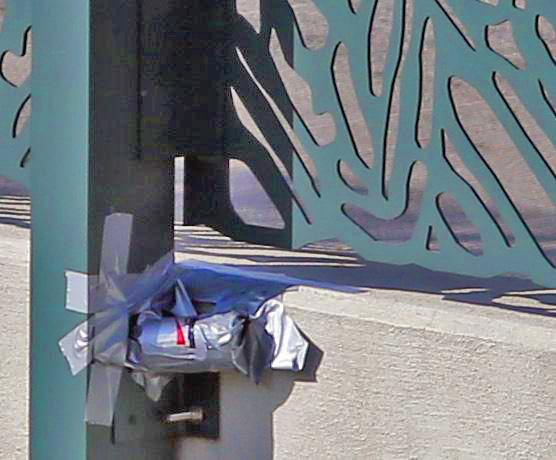
We live in an age governed by an authority that promotes social insecurity—one that capitalizes on the fear of some illusory enemy, reinforcing the over-exertion of power. According to French theorist Paul Virilio (and blatantly echoed by Boisvert), “the administration” controls with fear. Indeed, it’s not too hard to argue that the discourse of “for a safe(r) America” has redefined object-relations in our day-to-day life, with objects—in terms of their potential for unforeseen violence—examined through the lens of an ontology of anxiety and paranoia.
I get it—the duct-taped object looked like something along the lines of a homemade bomb. If I had been crossing the 14th Street Bridge on Monday around lunch, maybe I would have come to the same conclusion, a conclusion that would have been marked by my own submission to our country’s preoccupation with narratives prophesying some imminent terror that could be waiting around every corner.
What I find so frustrating about the response to Monday’s events in Atlanta is that a class art project—albeit poorly executed—caused a city to go into a panic. Even the next day, when another “suspicious object,” a.k.a. pinhole camera, was discovered in Hapeville, officials shut down the highway, even though they knew the cause of the previous day’s mayhem.
Like Hasan-Khan’s Gift, perhaps events such as this should prompt us to reassess our own codified sensitivity to the objects and notions that signal “terror.”
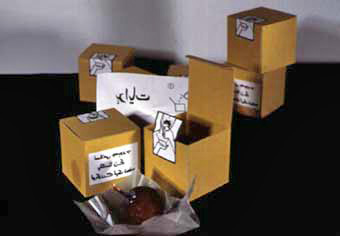
When Art Bombs
Related Stories
Reviews
Art21 x Burnaway
Reviews
A Landscaped Longed For: The Garden as Disturbance at the Crisp-Ellert Art Museum, St. Augustine
Christopher Stephen reviews the visual metaphors of the garden found in A Landscape Longed For: The Garden as Disturbance at the Crisp-Ellert Art Museum, St. Augustine.
The Incredulity of Jacolby Satterwhite
In April's Art21 x Burnaway feature, we enter and explore the resurrection, rebirth, and regenerative quality of Jacolby Satterwhite's virtual worlds.
Orchid Daze by Lillian Blades at the Atlanta Botanical Gardens
Blake Belcher reviews Atlanta-based Bahamian artist Lillian Blades' new work engaging orchids, transplantation, and diaspora at the Atlanta Botanical Garden.


